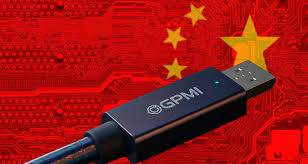In today’s digitally dense world, our devices rely on a tangle of cables, USB-C for charging, HDMI for video, DisplayPort for monitors, Thunderbolt for high-speed data. What if one cable could replace them all?
That’s exactly what China is setting out to achieve with GPMI-the General Purpose Media Interface, a revolutionary new standard launched in early 2025 by a consortium of over 50 leading Chinese tech companies, including Huawei, TCL, Hisense, and Skyworth.
What is GPMI?
GPMI is a universal cable technology designed to handle everything like video, audio, data, internet, and power delivery through a single interface. It’s being introduced in two forms: GPMI Type-C, which is compatible with existing USB-C ports, and GPMI Type-B, a proprietary ultra-high-performance version.
GPMI Type-B supports staggering performance numbers, offering up to 192 Gbps bandwidth, quadruple that of HDMI 2.1 and 480 watts of power delivery, enough to charge high-powered laptops and even some electric devices. The more mainstream Type-C version delivers up to 96 Gbps of bandwidth and 240 watts of power, while retaining full compatibility with existing USB-C hardware. Beyond speed and power, GPMI also integrates advanced Chinese cryptographic protocols for content protection and faster wake-up capabilities, making it not just powerful, but secure and intelligent.
Why Did China Develop GPMI?
GPMI is more than just a cable, it’s a calculated move in China’s long-term vision of technological independence. For decades, global cable standards like HDMI and USB have been controlled by Western alliances and companies. These standards come with licensing fees, regulatory dependencies, and external intellectual property ownership. GPMI shifts that balance by giving China its own foundational tech standard reducing reliance on foreign IP and asserting control over core infrastructure.
It also aligns with China’s “Made in China 2025” initiative, aimed at elevating the country from being a manufacturing hub to a global innovation leader. By setting its own standard, China not only secures its supply chains but also paves the way for its tech ecosystem to grow independently and competitively.
What Makes GPMI So Powerful?
GPMI’s appeal lies in its simplicity and performance. With just one cable, users can charge their device, stream high-resolution video, transfer data at lightning speeds, and maintain internet connectivity simultaneously.
It dramatically reduces port and cable clutter, simplifies product design, and supports demanding modern workloads like 8K+ video, AR/VR, AI computing, and smart home automation. Additionally, being backed by China’s expansive manufacturing infrastructure ensures that GPMI can be produced at scale and at competitive prices, potentially offering better value than Western counterparts.

The Global Impact of GPMI
GPMI’s introduction could reshape global tech in four major ways:
1. For Consumers and Workspaces
GPMI promises cleaner setups with fewer cables and faster, more reliable performance. It could become the new standard in Chinese-made laptops, monitors, TVs, routers, and smartphones.
2. For Manufacturing and Design
With fewer ports and simplified architecture, device makers can reduce cost, streamline design, and build more compact, efficient hardware.
3. For Industrial and Automotive Tech
In sectors like IoT, EVs, and smart infrastructure, GPMI enables integrated, high-throughput communication across devices, critical for automation and real-time systems.
4. For Global Technology Standards
This is perhaps the most significant. GPMI challenges the dominance of HDMI, USB, and Thunderbolt. If it achieves widespread adoption, GPMI could reset the global standard-setting landscape, affecting everything from licensing fees to device compatibility worldwide.
The Roadblocks Ahead
Despite its strengths, GPMI faces real challenges:
- Compatibility Concerns: Most of the world’s devices still run on existing standards. Adoption will require time, adapters, and perhaps hybrid ports.
- Geopolitical Tensions: Tech rivalry between China and Western nations may create resistance, especially in markets that prefer open or neutral standards.
- Ecosystem Inertia: USB and HDMI are deeply entrenched. Shifting global hardware ecosystems will take more than just a better spec as it will require strategic partnerships and strong market momentum.
Still, China’s decision to make GPMI Type-C compatible with USB-C shows a smart, gradualist approach, encouraging early adoption without forcing a total switch overnight.
Final Thoughts
The GPMI cable is not just a technological upgrade but it’s a bold symbol of strategic autonomy, innovation, and ambition. It reflects China’s growing confidence in shaping the future of tech infrastructure on its own terms.
Whether GPMI becomes a global standard or remains regionally dominant, one thing is clear: the world of device connectivity will never be the same again.
This time, the revolution comes not from software or silicon but from a single, silent cable that does it all.


Discussion
Start the conversation
No comments yet
Be the first to share your thoughts on this article. Your insights could spark an interesting discussion!